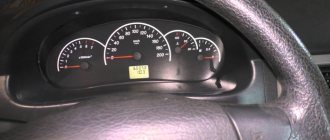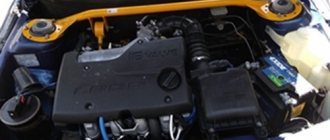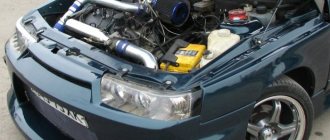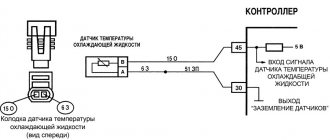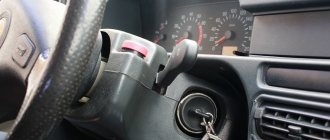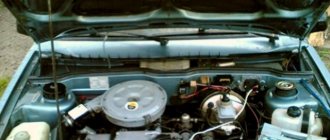Dips when pressing the gas pedal - carburetor
As noted above, the problem occurs in VAZ 2107, 2106, 2109 cars that have a carburetor installed. Mainly problems with the fuel system. It will most likely be clogged. Therefore, to identify the cause, the fuel supply to the carburetor is checked.
As a result of clogging, the operation of the fuel pump decreases, and the carburetor begins to receive less fuel. As a result, the engine starts and idles without problems, but when pressed, failures occur.
If everything is fine with the fuel system, then the fault must be looked for in the carburetor. It is responsible for dosing the supplied fuel into the air flow. If there are violations, failure occurs. However, first you need to check for air leaks. The carburetor may become loose, allowing air to leak through the gap, making the mixture lean.
The filter mesh must also be checked. It is located in the inlet fitting of the pipeline that goes to the fuel pump. If it is contaminated, then this is a consequence of failures.
Dips when pressing the gas pedal on the carburetor:
The pedal falls when the movement is set
The cause may be a faulty ignition. In this case, diagnostics and repair work are required.
You can try to fix the problem yourself:
- First, you need to look under the hood and inspect everything. Remove the key from the ignition and check whether the ignition coils are securely attached and seated on the spark plugs. Next, start the engine and listen to how it works.
- Replace spark plugs regardless of their condition and how long they last. Check the spark plugs - if they are damaged, engine repair is inevitable.
The gas pedal fails in a VW POLO sedan due to unstable operation of the damper position sensor, which is built into the cover itself. The engine idles intermittently, the engine power is reduced to a minimum - this all indicates that the sensor has failed.
The cover itself cannot be disassembled, so you will have to replace the entire throttle assembly.
Loss of traction due to power system failure
But still, if a drop in power is noticed and the car pulls poorly, you need to look for the cause in the power unit.
As with most cars, on a Priora, if a malfunction such as loss of power occurs, the check should begin with the engine power system, ignition system and gas distribution mechanism.
Description
| Cause | |
| Poor quality fuel | Such gasoline, having a large amount of impurities and water, causes interruptions in engine operation and loss of power. In order to get rid of the consequences of using low-quality gasoline, you will need to flush the power system. |
| Gasoline pump | .In some cases, when the car drives normally at low speeds, and a drop in power is observed only at higher speeds, this indicates that the performance of the fuel pump is not adequate for these speeds. To eliminate the malfunction, you need to check the condition of the fuel pump, rinse it if necessary and check its performance. |
| Fuel filter | If it is heavily contaminated, its throughput is significantly reduced, and the required amount of fuel does not enter the cylinders. |
| Injectors | If these elements of the power supply system of the power unit malfunction, unstable operation and a drop in power occur. Often the problem of injector malfunction is solved by flushing the power system. |
Diagnostics of fuel pump operation If all fuel supply mechanisms are working properly, you should check the air supply system: You need to check the condition of the air filter; if it is heavily soiled, it should be replaced.
After checking the filter, you need to pay attention to the performance of the mass air flow sensor and the throttle position sensor. If they malfunction, they provide readings to the electronic control unit that do not correspond to the driving mode, which leads to a loss of power in the Priora
If they malfunction, they provide the electronic control unit with readings that do not correspond to the driving mode, which leads to a loss of power in the Priora.
If everything is in order with the power system, and the car does not pull, you should check the oxygen concentration sensor in the exhaust gases, also known as a lambda probe. If it malfunctions, the car begins to over-consumption of fuel and loses power.
Why is it stupid? Basic faults
Type of VAZ-2112 engine
There are not many reasons for the effect when the 16-valve engine on the VAZ-2112 16 valves stalls. Of course, you will have to tinker a little in order to find the true reason in one case or another, but otherwise there is a direct road to a car service center. For those who have decided to repair their car themselves, this information will be useful.
So, let's look at the main reasons for this effect:
We clean the sensor from dirt and dismantle it.
The main reasons are considered, and you can move on to solving these problems.
Methods for solving the problem
To eliminate failure during overclocking, you need to check all the components listed below step by step. This is a considerable amount of work, but the car enthusiast will be able to save a sufficient amount of money, which would have been charged to him at a car service center. Of course, for those who don’t understand the design of a car, that’s the way to go, or ask your friends who will fix the problems for half the price. But, if you follow the instructions, you can figure it out yourself.
Poor quality fuel
Poor quality fuel is a common cause of engine breakdowns
Of course, in our country, low-quality fuel causes many misfortunes and troubles for motorists. It is not possible to check the fuel at a gas station, so everyone is already struggling with the consequences. The only thing that can be done is to carry out regular diagnostics and cleaning of the fuel system.
Fuel system
Injectors on the fuel rail removed from the engine
The first line of engine protection is fuel filters, which sometimes fail and not enough fuel gets into the engine. On the other hand, when completely clogged, the injectors are clogged, which at low speeds give a normal amount of mixture, but if the engine is accelerated, the amount of mixture remains the same and a failure appears at low speeds.
The way out of the situation is to replace the fuel filter, clean or replace the gasoline pump mesh, and diagnose and replace failed injectors. The latter usually go through a cleaning stage, but this does not always help and they have to be replaced.
Throttle valve
Cleaned throttle body
A stuck throttle valve and insufficient air supply can cause the engine to become sluggish when accelerating. This is due to a non-optimal fuel mixture. In this case, the solution to the problem is cleaning.
Ignition system
High voltage wires of the ignition system
Another reason that the car began to stall while accelerating could be interruptions in the ignition. So, it is necessary to check the spark plugs and high-voltage wires where breakdowns could occur. If necessary, damaged parts must be replaced. The manufacturer recommends replacing everything in sets.
If the diesel engine doesn't work
A decrease in traction can also occur in diesel engines. If we look at old cars that have completely mechanical power systems, then the most common cause is depressurization of the system.
As a result, air enters the fuel, which is why the fuel injection pump is unable to provide the required pressure.
Don't forget about:
- clogged filters;
- weakly pumping fuel priming pump;
- damaged plunger pair;
- Coking of injector nozzles.
And if we also add possible problems with the timing belt and CPG, then identifying the cause will not be so easy.
In modern diesel installations, where an additional electronic component is used, the search range will increase.
For example, the Common Rail system uses all the same sensors as the injection engine. And if at least one of them breaks, this will certainly affect the operation of the control part.
Jerks when cold
Many owners of the VAZ 2110 note that jerks occur when cold, and after warming up, the car gets into a rhythm while driving and stops “sausaging”. The main reason in this case is called a lean mixture, due to the fact that air is sucked in at idle. Or one of the sensors “died”.
If dips often occur when cold (as well as when driving), in addition to everything already listed, you need to check:
- spark plugs - if they have heavy carbon deposits, and even make poor contact with the wires, this needs to be corrected urgently. In the first case - by replacement, in the second, by cleaning and strengthening contacts;
- high voltage wires. Checked with an ohmmeter (multimeter). But if they even look old and shabby, it’s better to just replace them all at once;
- ignition coil. You need to check the armored wires and the ignition module while wearing rubber gloves, otherwise you may get a slight electric shock if there is a break;
- The timing belt can jump a couple of teeth, then when cold there may well be failures. Therefore, check whether the marks on the pulleys match. If not, the belt must be removed and set correctly;
- be sure to check the oxygen sensors (OS); mass air flow (MAF); idle air regulator (IAC), if a malfunction is detected, replace them;
- filters. In principle, they need to be checked first, even before serious damage occurs. Air and fuel filters are designed to give cars a clean mixture. That is, they take on all the debris particles, so they become clogged, worsening the dynamics of the car, and also increasing fuel consumption. They need to be changed regularly.
It is possible that the fuel injectors in a fuel-injected vehicle are clogged. Then you will need professional diagnostics in the service.
You should not miss one more point, because of which, when cold, as well as when driving, metamorphoses such as twitching can occur with the car: did you put the right gasoline in it? Advice to all car enthusiasts is always relevant: if possible, refuel at a reliable, proven gas station. Low-quality fuel can not only cause jerking, but also damage not only the fuel pump, but the entire engine.
Looking for air leaks
Since injection and carburetor engines are structurally different, especially their fuel and air systems, we will consider possible places for air leaks separately.
- Vacuum booster and its hoses;
- Idle air control (if equipped) in the sensor area;
- Intake manifold gasket;
- Canister purge valve;
- Throttle assembly gasket;
- Injectors (via O-rings);
- The pipe between the throttle body and the air filter.
- Pipes of the crankcase ventilation system.
- Receiver studs.
Points 1 and 3 above are also typical for carburetor engines. Next, you should pay more attention to the carburetor, since it is there that air is most often sucked in, namely:
- Through the gasket located under the carburetor;
- Through failed diaphragms of the economizer damper, starting throttle.
- Incomplete fit of the throttle valve (for example, as a result of its clogging);
- Through the fuel mixture quality screw;
- Air leaks through the throttle axles.
Dips when pressing the gas pedal during acceleration
Determined using computer diagnostics or the steps described below:
- The first thing you need to do is inspect the spark plugs. To do this you need to remove them. The presence of carbon deposits on the spark plugs, poor contact with the wires, or an excessively lean or rich mixture lead to spark plug malfunctions.
- High voltage wires can also cause engine malfunction, as can ignition coils.
- The throttle needs to be checked. If it is clogged, this causes the engine to respond untimely when pressing the gas pedal.
- It is necessary to check the condition of the air, fuel and oil filters. They tend to get clogged, which worsens dynamics, increases fuel consumption and causes pedal failure. They need to be changed constantly, you can do it yourself, they are inexpensive and easy to install.
- The presence of errors in the ECU leads to failures.
- Clogged injectors. If necessary, replace or repair injectors.
The wires, as well as the rubber bands on them, should not be damaged and should not spark when the engine is running. If damage is found, this indicates that the engine is shaking and jerking begins. This may occur due to the age of the car, worn-out or low-quality spare parts, poor contact with the spark plugs, or due to the temperature of the engine.
The resistance of the coils and the temperature change together, as a result of which a gasoline car begins to jerk during acceleration. In diesel cars, jerking cannot be associated with the coils, since they are not present.
Posts 1 to 20 of 22
1 Topic by SMD_qsk 2014-02-12 20:58:53
- SMD_qsk
- New member
- Inactive
- From: Kazan
- Registration: 2014-02-12
- Messages: 25 Thanks : 5
- Car: VAZ 21102
Topic: Resolved: The car stalls when accelerating, whether cold or warm
Hi all! I apologize for creating this topic, because there are a lot of similar ones on the Internet, but I haven’t encountered anyone with my specific problem, it seems (!). Maybe I was looking wrong!? Car VAZ 21102, 1.5, 8Kl, 2003.
The problem is that the car stalls when accelerating. Whether cold or warm, there is no difference. In any gear, be it 1 or 5, I press the gas pedal 50%, the car seems to be held by the ass. 60%, similar. 70% nothing changes. But when the throttle opens 100%, only after that does it start driving like crazy. There are no jerks when accelerating, it just feels like I’m dragging someone in tow. BUT, sometimes(!) she behaves normally... very rarely, but there are such joyful moments. Then everything repeats itself. The car idles stable and starts without problems in any weather.
I changed: filters (in the tank and under the tank), TPS, IAC, ignition module, spark plugs, wires. I cleaned the injectors and also cleaned the damper. The fuel pump, fuel pressure regulator and mass air flow sensor remained untouched.
What to do if the starter spins for a long time when starting the engine
Despite the fact that starting the engine falls almost entirely on the starter and battery, we must not forget about other elements that are involved in solving this problem. The following are the most common reasons why the starter spins for a long time when starting the engine:
- Dirty fine fuel filter. If low quality fuel is used or various debris gets into the gas tank - sand, dust, stones, then over time the fine fuel filter will become clogged. This will lead to difficulties in the flow of fuel into the combustion chamber, which will cause difficulties when starting the engine and its operation. In such a situation, you need to change the fine filter to a new one and clean the gas tank from accumulated contaminants;
- Worn starter brushes. The longer the starter is used, the more its brushes wear out. Replacing starter brushes is a simple procedure, but it is not always advisable. If the starter is old, sometimes it is better to install a new one in its place instead of replacing the brushes;
- Air filter dirty. Due to accumulated contaminants in the air filter, difficulties will also arise with the operation of the engine, especially at the time of start-up. It is recommended to replace the air filter and clean the air intake system;
- Low compression in cylinders. This problem is relevant for older cars. Due to low compression in the cylinders, exhaust gases leak into the crankcase, which disrupts the ignition process of the fuel-air mixture when starting the engine. To correct the situation, you can try decoking the piston rings. When it does not help and the problem is related to a change in the shape of the cylinders, only a major overhaul of the engine can correct the situation.
The above are the most common problems for any type of engine, but we can also highlight characteristic malfunctions for injection and carburetor engines.
The starter spins for a long time on an injection engine
A typical problem with an injection engine, due to which it takes a long time to crank the starter to start the engine, is an error in the on-board computer. This problem can be solved in two ways:
- By reflashing the on-board computer at a service center (or resetting errors);
- Resetting the on-board computer memory by disconnecting the battery. It is necessary to remove the wire from the negative terminal of the battery for 15-20 minutes so that errors are automatically deleted from the memory of the on-board computer, if they were recorded in it.
The starter spins for a long time on a carburetor engine
A tool for diagnosing problems in a carburetor engine are spark plugs. They need to be unscrewed and the condition of the electrode inspected, by the color of the deposit on which you can determine the presence of problems in the engine:
- Dark red, brown soot indicates low quality of the fuel used. Most likely, such fuel contains metal impurities;
- Black or white carbon deposits indicate a rich or lean air-fuel mixture, respectively. It is necessary to check the fuel supply system, filters, carburetor;
- The light brown color of carbon deposits on the electrode is an indication of normal engine operation.
If the starter spins for a long time when starting the engine, first check the battery, and only then all other engine components. In most cases, it is the lack of battery charge that causes difficulties when starting the engine.
(395 votes, average: 4.50 out of 5)
Stalls when the choke is turned off, then starts
Hello people, I’m telling you the problem, last year, when the temperature dropped to +10 and below, the engine became very difficult to start, it could barely idle with the choke pulled up, it warmed up and then it was fine (but you can’t warm it up when it’s cold, I’m already silent about +3 + 5). We turned the mixture 3-4 turns (instead of 2 turns) at idle speed (the screw is at the very bottom of the carb), it started up perfectly, but a problem arose, which I decided to deal with after wintering. Now winter is over, +15 during the day, the actual problem:
1) pull out the choke, start it - everything is fine 2) warm it up, just touch the choke to remove it, the engine stalls (warm it up for at least 5 minutes, at least 10, it doesn’t matter, it’s definitely not due to lack of warming up) 3) after that it starts perfect with half a kick (without suction of course)
What did I do
I did not self-medicate, because, as experience shows, this is a waste of money in the absence of a convincing positive effect.
- I did computer diagnostics, according to the results of which long-term fuel corrections were in the positive: the engine does not have enough fuel-air mixture. The control unit compensated for this deficiency by increasing the opening time of the injectors, so the car “stuck” at the start. The MAF sensor readings were low, indicating that the air filter was dirty.
- I changed the air filter because it had become clogged during my summer travels.
- My spark plugs are excellent, there is no carbon deposits. Despite my creativity, I do not change the brand of fuel station; I try, as they say, not to look for good from good.
- I changed the fuel filter, and not just changed it, I flushed the fuel system. Previously, I did this procedure once a year on all my cars, I always liked the way the car was after it - playful and responsive, reacting to the gas pedal immediately when pressed.
And I started the current car for some reason, until now it remained without flushing. The procedure itself takes about 2.5 hours, that’s all, and the result is visible under your feet. Now the car is obedient and “sensitive”, it’s very pleasant to drive. The “responsiveness” of the car, in addition to driver comfort, is also an important safety factor, so if you are a fan of fast driving like me, I RECOMMEND it. The work itself on flushing the fuel system is inexpensive, only 1,980 rubles. The amount of costs is “pull up” by the fuel filter - with this procedure it makes no sense to wash the fuel and not change the filter, but it’s worth it, it’s not a wasteful expense.
If you receive a lot of questions about this process, in the next newsletter I can clearly tell and show you everything, with an arrangement and photo illustrations. I can add on my own behalf – flushing the fuel system is wow! I had no idea that my car was so agile and powerful, yo-ho-ho!!
I wrote the main and most probable reasons for a possible decrease in engine power - you need to remember that there are a great many such reasons, from engine malfunction to a sintered catalyst, from a faulty fuel pump to a dirty throttle valve. If you were unable to install them yourself, then you definitely need to go to us and entrust this task to professionals.
How to disconnect the throttle cable from the throttle valve?
In order to disconnect the throttle cable from the throttle valve, it is necessary to remove the locking plate...
...and remove the end of the throttle cable from the grooves.
Then you need to unscrew the three nuts from the receiver studs that hold the throttle cable bracket with the adjusting nuts. Some people recommend unscrewing the adjusting nuts and removing the cable without the bracket, but in this case, during assembly you will have to adjust the tension of the throttle cable, and we don’t need to waste time, which, as we know, is money.
After lubricating the cable, the gas pedal will again become light and responsive. I hope that the article on how to lubricate the throttle cable was useful to you. You can read other useful articles on the 1 VAZ website.
Search
Long-term VAZ 2110
injector? Fix it yourself
Patriots of the domestic automobile industry often face a problem: the long mileage of the VAZ 2110 injector
. We will make reservations immediately. in most cases, this is not due to the design features of the car, but to the low level of prevention on the part of car owners.
As they say, “thunder will not strike.” In other words, our compatriots prefer to heroically and selflessly eliminate malfunctions rather than prevent them.
The list is not exhaustive, but it identifies the main causes of engine starting problems. Analysis provides the only reliable way to avoid problems. have enough time to carry out preventive inspections and replace questionable components (for example, sensors are guaranteed to work for 60,000 km. run
) Of course, this advice cannot console those who have already encountered a breakdown, but for the future.
We will tell you more about these breakdowns. As for the timing belt, everything is clear. it needs to be changed as it wears out.
may break during vehicle operation. Let's say the ignition module wire often melts from high temperature (it is located in close proximity to the device head and regularly overheats).
Bad start VAZ 2110, injector 16 valves.
There are other possible causes of insulation integrity failure. The resulting short circuit prevents the engine from starting. and this defect may occur periodically.
. If this part has a malfunction (and even more so if it fails), problems arise with checking the on-board computer. it cannot correctly determine the engine temperature and, accordingly, the required amount of fuel mixture. The only (and least expensive) way to “cure”. this is to replace the sensor. You can, of course, test it for functionality, but this requires special equipment.
bad to catch a cold? | Replacing the DTO | VAZ2110 16cl
The car got off to a bad start
? Not for the first time? Capture and stop? Has your consumption increased? Turnover
Ignition module. It is difficult to repair at home, so the “recipe” is the same. replacement. If you can temporarily install a known-good module and try to run it, try it.
. Apparently, fault diagnosis should begin with them. Soot, the presence of traces of fuel and other deviations from the norm necessarily indicate a malfunction. See spark plug fault.
The VAZ 2110 16 valve starts and stops.
For beginners, the best solution is to completely replace the set; people who are not familiar with technical skills can try to “revive” the candles. gently wipe them, remove carbon dioxide, burn them with gas and much more. If, after replacing the spark plugs, they are filled again, there is a high probability of damage to the integrity of the insulation in the high-voltage wires.
By the way, with a working spark plug it is easy to check for a spark: you need to place the spark plug on the weight of the car with a metal surface and start the starter. The absence of a spark indicates a power problem; in a positive case, it is necessary to continue the diagnosis.
Let us indicate one more reason for the malfunction: low throughput of the fuel filter. This is entirely on the conscience of the car owner, who ignored the timely replacement of the part, although it is quite possible that the filter was clogged due to bad fuel.
We hope that the reasons briefly discussed here and ways to eliminate them will allow us to answer the question why the VAZ 2110 injector needs long-term operation.
Posts 6
1 Topic by max_fil 2016-10-15 15:34:14
Topic: Resolved: VAZ 2110 8 valves fails and has no traction
Hello Tazavod. I came across this problem. 2110 8 valve injector. Doesn't want to go. It is gaining momentum very poorly, one might say it is not gaining momentum at all. Big failures. Choke or whatever you can call it. I replaced all possible sensors (crankshaft, idle speed, throttle, cleaned injectors, changed spark plugs, armored wires, fuel pump mesh). Nothing helped. Such a strange thing was noticed, under load, in neutral everything seemed to be normal. When driving, when a failure occurs, you press the gas pedal to the floor, it seems to be trying to go, then slowly releasing the gas, it gains momentum. Where to go, what to look for? PS. I didn't measure the compression.
2 Reply from Sergey VAZ 2111 2016-10-15 18:08:09
Re: Resolved: VAZ 2110 8 valves have dips and no traction
If this problem suddenly arises, it means there is no compression. You need to check the fuel pressure in the rail. Either the fine filter is clogged, or the pump is tricky, or the check valve is tricky.
Reasons for difficulty starting a car in cold weather
Novice drivers are interested in the question of why the car does not start in cold weather. There are plenty of reasons: problems with the battery and starter, an increase in lubricant thickness, disruption of the fuel supply in the system, as well as the use of summer grades of diesel fuel in diesel cars.
Battery problems
The battery is the main culprit for problems with starting a car in cold weather, especially if the battery has been actively used for more than 3 years - at this time its power begins to decrease. In addition, particles of rust and dirt accumulate on the battery terminals over time, and oxidation of the terminals and contacts can be caused by temperature fluctuations: when the motor is turned off, the wires have the same temperature as the environment, and at the moment of starting they begin to heat up. This process leads to a gradual breakdown of the integrity of the connections.
Chemical processes inside the battery slow down at sub-zero temperatures: already at -15...-20°C it operates at only 40% of its potential even when fully charged - this is another reason for problems with starting the engine.
Starter malfunction
It is not uncommon for the starter to break down in winter. This unit is subject to critical loads in cold weather due to:
- thickening of lubricants;
- freezing of moving parts of parts due to condensate freezing on them;
- changes in resistance at the contacts.
All this leads to an increase in the current flowing through the armature, which causes incorrect operation of the unit, and sometimes even destruction of the armature, starter brushes, and commutator lamellas.
Thickened motor oil
At subzero temperatures, lubricants tend to become thicker, which increases resistance in rotating and moving mechanisms. This, in turn, increases the load at the starting moment on the battery, which is also cooled, as a result of which the battery discharges faster. Using special winter brands of oil can partially solve the problem.
The coolant also works only in the temperature range specified by the manufacturer; when this indicator decreases, it freezes. At the same time, the starter will continue to rotate, which often causes breakdown of the entire unit and makes it impossible to operate the car. To avoid this, use coolant designed for the appropriate climate conditions.
Bad gasoline or its supply is interrupted
The use of low-quality fuel also becomes a problem. The drops of moisture contained in it, freezing, form ice plugs that prevent the normal flow of the mixture into the combustion chamber. You can prevent trouble by using high-quality fuel or specialized additives.
In cold weather, the operating parameters of fuel pumps deteriorate, which leads to problems in the functioning of injectors and nozzles. Misfire may occur in some or even all cylinders.
The ignition system is misregulated
The main “winter” enemy of the fuel system, which causes its imbalance, is moisture entering the unit in the form of condensate. It freezes at sub-zero ambient temperatures, preventing the flow of the fuel-air mixture.
Spark plugs flooded
In winter, it is necessary to use proven spark plugs; it would be a good idea to change them in the off-season, before the first cold weather begins, and also have a spare set of spark plugs with you. In addition to the general problems that can arise at any time of the year, there is also a typical “winter” problem - the candles are flooded with fuel.
In the cold, the formation of a combustible mixture requires a change in conditions. In frosty air, the concentration of oxygen is increased, and accordingly, more gasoline will be needed, and the command to increase the fuel supply is sent by the electronic control unit to the injector nozzles. A cold starter produces a weak spark, and meanwhile the injectors continue to supply fuel to the system, which fills the spark plugs.
The use of summer diesel fuel in diesel cars
A diesel car may not start in winter due to the use of the wrong fuel. Summer diesel fuel - a special type of diesel fuel - can only be used at an ambient temperature of at least -5°C, because already at -6°C it becomes cloudy and thick, and at -7... -8°C it begins to solidify.
The crystals formed in this process:
- the fuel filter is clogged;
- accumulate in the heat pipe;
- damage the engine and other components of the mechanism.
If it is not possible to use winter fuel, you should definitely use special additives for diesel fuel.
Fuel pressure regulator is faulty
It is impossible to achieve the desired speeds when accelerating a vehicle if the product does not correctly “perform” fuel return. The moment of release occurs provided that the pressure has exceeded the standard parameters. If the regulator is faulty, fuel will begin to flow back into the tank prematurely. That is, when accelerating a car, it will not reach the required speed, since the power of the propulsion system will drop.
Check the serviceability of the regulator using an air pump. For the control process, it is necessary to prepare a special rail and air blower. It can be not only a pump. It is recommended to use a compressor to speed up the action. While pumping air, monitor the readings of the rack. When the regulator operates, look at its readings. When it operates before reaching the control mark, it must be repaired or replaced with a new regulator.
Experienced motorists claim that a cracking sound appears in the engine compartment due to a faulty fuel regulator.
Dips when pressing the gas pedal - carburetor
As noted above, the problem occurs in VAZ 2107, 2106, 2109 cars that have a carburetor installed. Mainly problems with the fuel system. It will most likely be clogged. Therefore, to identify the cause, the fuel supply to the carburetor is checked.
As a result of clogging, the operation of the fuel pump decreases, and the carburetor begins to receive less fuel. As a result, the engine starts and idles without problems, but when pressed, failures occur.
Tired of failures?
Contact qualified specialists. With us you can choose a car service that is closer to you and ask for help. They will help you with your problem.
Eliminate
If everything is fine with the fuel system, then the fault must be looked for in the carburetor. It is responsible for dosing the supplied fuel into the air flow. If there are violations, failure occurs. However, first you need to check for air leaks. The carburetor may become loose, allowing air to leak through the gap, making the mixture lean.
The filter mesh must also be checked. It is located in the inlet fitting of the pipeline that goes to the fuel pump. If it is contaminated, then this is a consequence of failures.
Dips when pressing the gas pedal on the carburetor:
Diagnostics
Checking the injector is faster because there is an electronic control unit. After reading the error codes, the source of the problem can be clearly identified. Carburetor cars do not have this option. Therefore, such a system is diagnosed in its own way.
First you need to check the coherence and correct operation of the fuel system. You have to probe all the places where air leaks may occur. The fuel pump and fuel line are also checked. There should be no deposits or blockages.
If the test results do not reveal any problems, the failure most likely occurs due to the carburetor. This is the main device responsible for mixture formation and intake into the manifold. When the carburetor is working properly, fuel flows evenly without interruption.
Jerks when cold
Many owners of the VAZ 2110 note that jerks occur when cold, and after warming up, the car gets into a rhythm while driving and stops “sausaging”. The main reason in this case is called a lean mixture, due to the fact that air is sucked in at idle. Or one of the sensors “died”.
If dips often occur when cold (as well as when driving), in addition to everything already listed, you need to check:
- spark plugs - if they have heavy carbon deposits, and even make poor contact with the wires, this needs to be corrected urgently. In the first case - by replacement, in the second, by cleaning and strengthening contacts;
- high voltage wires . Checked with an ohmmeter (multimeter). But if they even look old and shabby, it’s better to just replace them all at once;
- ignition coil . You need to check the armored wires and the ignition module while wearing rubber gloves, otherwise you may get a slight electric shock if there is a break;
- The timing belt can jump a couple of teeth, then when cold there may well be failures. Therefore, check whether the marks on the pulleys match. If not, the belt must be removed and set correctly;
- be sure to check the oxygen sensors (OS); mass air flow (MAF); idle air regulator (IAC), if a malfunction is detected, replace them;
- filters. In principle, they need to be checked first, even before serious damage occurs. Air and fuel filters are designed to give cars a clean mixture. That is, they take on all the debris particles, so they become clogged, worsening the dynamics of the car, and also increasing fuel consumption. They need to be changed regularly.
It is possible that the fuel injectors in a fuel-injected vehicle are clogged. Then you will need professional diagnostics in the service.
Adjusting the drive:
- Checking the length between the tips. The required size is 80 millimeters.
- If you deviate from this size, remove one tip.
- Loosen its lock nut and by rotating adjust the distance to the desired size.
- Tighten the nut and return the rod.
- You need to check the adjustment. To do this, our assistant presses the gas pedal. We observe the throttle valve to see if it has opened completely.
- If not, then you need to remove the tip from the lever and reduce the length of the rod.
- Now you need to see what position the damper is in when the gas pedal is released: does it close completely. If not, the pull needs to be lengthened a little.
- Next we work with the air damper. We weaken its drive. In the cabin, we completely recess the damper.
- Press the three-arm lever so that the flap opens all the way. In this position, tighten the locking screw.
- Checking the adjustment. To do this, we completely close and open the door from the passenger compartment again. If the damper has not opened completely, we carry out the adjustment again. If the outcome is positive, fully tighten the screw.

